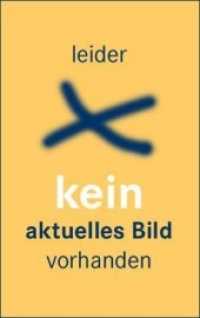- ホーム
- > 洋書
- > 英文書
- > Nature / Ecology
Full Description
For decades, students learning the Arabic language have begun with Modern Standard Arabic (MSA) and then transitioned to learning spoken Arabic. While the MSA-first approach neither reflects the sociolinguistic reality of the language nor gives students the communicative skills required to fully function in Arabic, the field continues to debate the widespread adoption of this approach. Little research or evidence has been presented about the effectiveness of integrating dialect in the curriculum. With the recent publication of textbooks that integrate dialect in the Arabic curriculum, however, a more systematic analysis of such integration is clearly becoming necessary. In this seminal volume, Mahmoud Al-Batal gathers key scholars who have implemented integration to present data and research on the method's success. The studies address curricular models, students' outcomes, and attitudes of students and teachers using integration in their curricula. This volume is an essential resource for all teachers of Arabic language and those working in Teaching Arabic as a Foreign Language (TAFL).
Contents
Preface Part 1: Dialect Integration: A New Frontier for Arabic1. Dialect Integration in the Arabic Foreign Language Curriculum: Vision, Rationale, and ModelsMahmoud Al-Batal2. To Separate or to Integrate, That Is the Question: The Cornell Arabic Program ModelMunther Younes3. Lessons Learned and Empirical Data from Twenty-Five Years of Using an Integrated ApproachR. Kirk Belnap4. Preparing Arabic Teachers for Integration: The Edinburgh ModelJonathan Featherstone5. Preparing Students for the Future: Integrating Dialect and Standard into the Arabic Foreign Language ClassroomLizz HuntleyPart 2: Curricular Models and Approaches to Integration6. A Digitally Assisted Model of Integration of Standard and Colloquial Arabic Based on the Common European FrameworkManuela E. B. Giolfo and Federico Salvaggio7. Developing a Genre-Based Curriculum to Teach Arabic DiglossiaEmma Trentman8. An Integrated Moroccan and Modern Standard Arabic Curriculum for First-Year LearnersMike Turner9. Arabic Diglossic Speaking without Mixing: Practices and Outcomes from a Beginning LevelSonia Shiri and Charles JoukhadarPart 3: Integration and Skill Development 10. Integrating Colloquial Arabic into the Arabic L2 Curriculum: An Analysis of Learner SpeechLama Nassif11. Diverse Speaker Output in the Integrated Classroom: Trends and InterpretationThomas Leddy-Cecere12. Effects of Integrated Arabic on Written Language Skills at West Point: A Longitudinal Study Gregory R. Ebner and Jeff WatsonPart 4: Learners' and Teachers' Voices and Perspectives13. Integrating Colloquial Arabic in the Classroom: A Study of Students' and Teachers' Attitudes and EffectsMartin Isleem14. Dialect Integration: Students' Perspectives within an Integrated ProgramMahmoud Al-Batal and Christian Glakas15. Integration and Students' Perspectives in a Multidialect EnvironmentMai Zaki and Jeremey Palmers16. Teachers' Voices: Analysis of Teachers' Speech and Teachers' Perspectives in Integrated Arabic ClassroomsCaroline NajourList of ContributorsIndex








